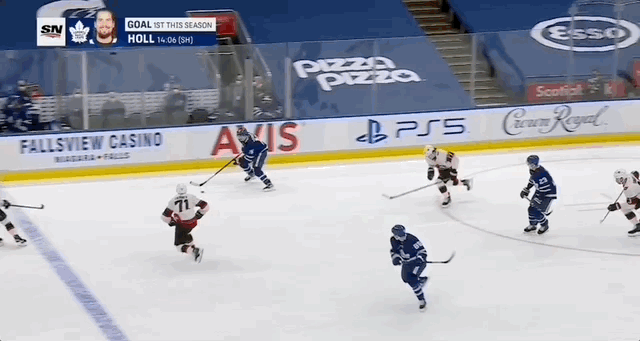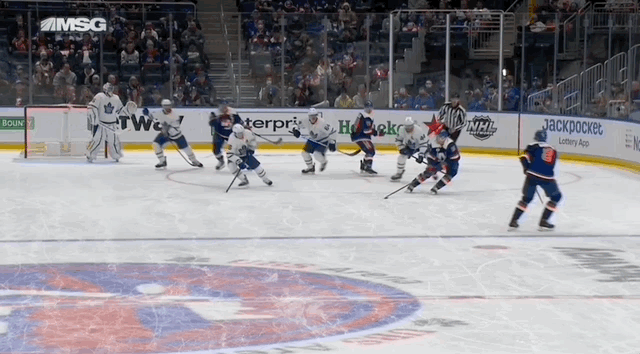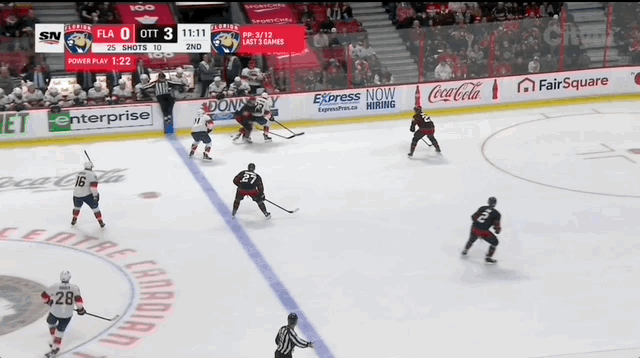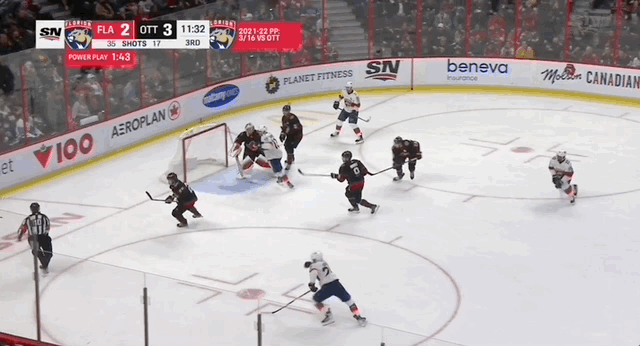The Atlantic Division is incredibly competitive, and all four teams in the playoff race — Toronto, Florida, Tampa Bay, and Boston — added at the deadline, bringing more intrigue to the playoff race. And two of those teams, who could matchup sometime in Round 1, or even Round 2 if they get past their demons, are set to play tonight.
The Panthers will take on the Maple Leafs in what should be a fast-paced matchup. One aspect that stands out, in particular, is a special teams battle between Florida’s loaded power play and Toronto’s skillful penalty kill — especially with some of their new additions in mind.
On the surface, the Maple Leafs’ penalty kill ranks fifth in the league operating at 84.4 percent going into Saturday’s game. A deeper look helps break down their play even further and highlight just how effective it is.
While short-handed, Toronto allows the second-lowest rate of shot attempts against — 81.1 per 60, which trails only Carolina. They also close passing lanes, keeping opponents to the second-lowest rate of pass attempts and completions on the penalty kill. Both north-south passes and lateral passes are limited. By stunting pass attempts, that helps the team take away one-timer opportunities.
One-timers are considered to be a particularly dangerous shot on the power play because the pre-shot movement that precedes the shot can challenge a goaltender. It’s even more difficult when that shot comes from a winger’s off-wing and improves the shooting angle. The Maple Leafs work to limit those shots against in general, and from the higher danger areas of the ice. The only team to allow fewer are the Hurricanes.
When it comes to quality chances, the Maple Leafs also work to keep their opponents outside of the slot, conceding the sixth-lowest rate of attempts (44.0 per 60) in the league. They rate similarly in puck movement to that area of the ice, too. The addition of Mark Giordano should only boost their already strong defensive efforts.
What makes their penalty kill so effective isn’t just their play on one end of the ice, though. It’s how they drive play out of their own zone and up the ice. No one carries the puck out of their own end more than the Leafs’ 19.0 exits per 60 in short-handed situations, nor does any team rank as highly in pass attempts to exit with control.
Their forwards are driving that. Among players with at least 50 short-handed minutes, Toronto has five forwards in the top-20 in controlled exits: Ondrej Kase, Ilya Mikheyev, Alex Kerfoot, Pierre Engvall, and Mitch Marner. These forwards, along with deadline acquisition Colin Blackwell, can all create some short-handed chaos, disrupting teams in power-play formation by intercepting passes and jumping on bobbled pucks.
From there, quite a few players on these PK units can create offence — none at a higher rate than Mikheyev. Usage plays into that as teams often deploy more offensively inclined players on the fly; that can bring some fresh legs out while top power-play units or less high-octane second units are on the ice. As the work of Prashanth Iyer highlighted, players with higher on-the-fly starts than face-offs tend to be on the ice for fewer quality chances against and more offensive chances-for. That holds true in Toronto.
But their first unit — Marner and David Kampf — also are effective on both ends despite usually going over the boards first to start a penalty kill and overall starting at the dot about 67 percent of the time. Kampf’s defensive efforts and Marner’s two-way play make that pairing such a threat, even against top power play units.
That all contributes to the Maple Leafs leading the league in short-handed shot attempts for at 21.6 per 60. Those shots tend to reach the net in about 71 percent of their attempts.
It’s not just a matter of creating offense, either — the Toronto creates quality shots better than any other team on the penalty kill with 10.9 attempts per 60 from the slot. With that shot generation in mind, it’s no surprise this team has the highest rate of goals scoring in these situations.
How does that matchup against Florida?
Going into Saturday night’s games, the Panthers’ power play was operating at 23.5 percent for 10th in the league. Their success generally comes from the top unit that plays between 60 and 70 percent of the available minutes. The mainstays of that unit are Aleksandar Barkov, Jonathan Huberdeau, Sam Reinhart, and Aaron Ekblad. Anthony Duclair’s often the fifth forward to round out that group.
But since the trade deadline, there’s one key add who belongs right on PP1: Claude Giroux. With the Ekblad injury, the team has a simple solution to switch out these players: literally going one-for-one despite the positional differences.
This isn’t the first time the Panthers have experimented with a five-forward top power play unit in small stints. They experimented with it under former assistant coach Paul McFarland a few seasons back, and even worked with it last postseason against the Lightning.
Against Montreal on Thursday, that power play generated some quality offense. After not converting, defender MacKenzie Weegar shifted up to that unit late in the game. That unit did score.
But that didn’t stop the Panthers from rolling out their five-forward power play against Ottawa, who created some quality looks and finished, thanks to a tally from Duclair.
Season-wide, usually in a four-forward one defender formation, the Panthers’ offensive generation actually ranks lower than their results. Their shot rate (93.5 attempts per 60) ranks 26th but over 53 percent of those shots come from the slot. Still, their slot attempt rate puts them 16th — as does their expected goal generation when accounting for ‘shot quality’ and pre-shot movement. But their shooting talent is what helps push their goal-scoring above expectations.
Now with more offensive firepower in Giroux, it’ll be interesting to see whether the team can boost their underlying numbers to improve their power play.
The forward scored 3.74 points per 60 with the Flyers on the advantage, which is by far the worst rate of his career — and not near the heights of his peak which was over seven points per 60 on the power play. Some decline in his game at 35 years old is to be expected, but his surroundings didn’t help — the Flyers’ power play has been below average in their offensive generation throughout the season. Still, he was one of the most frequent shooters in this situation on his club, often getting to the slot, and the best passer on the team in terms of quantity and quality.
The team still has to weather the loss of Ekblad who can hold the blue line to keep the play alive in the o-zone, take a one-timer from the point, or send the puck up to his teammates.
Now a Selke-caliber two-way center takes over that role in Barkov. He can direct play and catch up to opponents rushing the other way. Just take his defence against Alex Forementon last night.
This is the position to watch: if the coaches feel they’re losing zone-time because there isn’t a defender at the point, that may move Barkov back up to his usual position and Weegar to man the blue line.
With Barkov playing the point, they can look to Giroux at the face-off dot so there’s less pressure on the center to get back into position.
The team just has to figure out the best positioning for Giroux in those situations. Against Montreal, it was the right circle with Huberdeau in the left. That kept both forwards on their on-side which can help defensively. And on a unit without a defender, having each skater just a bit more responsible with the puck on their stick can help.
That was changed against Ottawa, with Giroux primarily playing the right and Huberdeau the left. That puts both forwards in a better position for one-timers and improved shooting angles.
The Panthers have to see if they can build on their five-forward power play formation. And their meeting tonight against the Maple Leafs gives them a test against a true power kill.
Data via Sportlogiq, collected prior to Sunday’s matchups.






